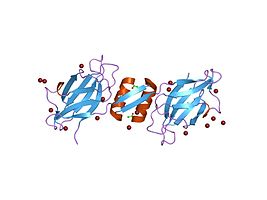Fungal immunomodulatory proteins (FIPs) are a type of functional compound (other compounds include polysaccharides and triterpenoids) found in various species of fungi. FIPs are part of the immunoglobulin (ig) family, which are structurally similar to human antibodies, and can interact with human peripheral blood mononuclear cells (PBMCs), causing these cells to secrete different types of hormones and regulate cellular activity.[1]
| Fungal immunomodulatory protein | |||||||||||
|---|---|---|---|---|---|---|---|---|---|---|---|
 | |||||||||||
| Identifiers | |||||||||||
| Symbol | FIP | ||||||||||
| Pfam | PF09259 | ||||||||||
| InterPro | IPR015339 | ||||||||||
| |||||||||||
History
editThe first FIP was discovered in 1989 by Japanese scientist Kohsuke Kino et al. from the water extract of the mycelium of Ganoderma lucidum, and was named Ling Zhi-8 (LZ-8).[2]
From then on, researchers have identified numerous structurally similar proteins from various types of fungi that also share a high degree of genetic similarity as well as physiological activities, and thus coined the term fungal immunomodulatory protein (FIP).[3]
Members of the FIP family
editCurrently known FIPs[3] are listed below:
- LZ-8 from G. lucidum
- LZ-9 from G. lucidum[4]
- FIP-gts from G. tsugae[5]
- FIP-gsi (NCBI DNA Accession number AY987805; Protein Accession number AAX98241) from G. sinensis
- GMI (FIP-gmi) (NCBI GI Accession number 310942694; Protein Data Bank Accession number 3KCW_A) from G. microsporum
- FIP-tve (NCBI DNA Accession number XM_008037967; Protein Accession number XP_008036158) from Trametes versicolor
- FIP-pcp from Poria cocos[6]
- FIP-fve (NCBI DNA Accession number GU388420; Protein Accession number ADB24832) from Flammulina velutipes
- FIP-vvo from Volvariella volvacea[7]
- FIP-aca from Antrodia camphorate[8]
- FIP-lrh from Lignosus rhinocerotis[9]
References
edit- ^ Ejike UC, Chan CJ, Okechukwu PN, Lim RL (December 2020). "New advances and potentials of fungal immunomodulatory proteins for therapeutic purposes". Critical Reviews in Biotechnology. 40 (8): 1172–1190. doi:10.1080/07388551.2020.1808581. PMID 32854547. S2CID 221357771.
- ^ Kino K, Yamashita A, Yamaoka K, Watanabe J, Tanaka S, Ko K, et al. (January 1989). "Isolation and characterization of a new immunomodulatory protein, ling zhi-8 (LZ-8), from Ganoderma lucidium". The Journal of Biological Chemistry. 264 (1): 472–478. doi:10.1016/S0021-9258(17)31282-6. PMID 2909532.
- ^ a b Liu Y, Bastiaan-Net S, Wichers HJ (2020). "Current Understanding of the Structure and Function of Fungal Immunomodulatory Proteins". Frontiers in Nutrition. 7: 132. doi:10.3389/fnut.2020.00132. PMC 7461872. PMID 33015115.
- ^ Peek HW, Halkes SB, Tomassen MM, Mes JJ, Landman WJ (2013). "In vivo screening of five phytochemicals/extracts and a fungal immunomodulatory protein against colibacillosis in broilers". Avian Pathology. 42 (3): 235–247. doi:10.1080/03079457.2013.780121. PMID 23627727. S2CID 24714876.
- ^ Lin WH, Hung CH, Hsu CI, Lin JY (August 1997). "Dimerization of the N-terminal amphipathic alpha-helix domain of the fungal immunomodulatory protein from Ganoderma tsugae (Fip-gts) defined by a yeast two-hybrid system and site-directed mutagenesis". The Journal of Biological Chemistry. 272 (32): 20044–20048. doi:10.1074/jbc.272.32.20044. PMID 9242675.
- ^ Chang HH, Yeh CH, Sheu F (July 2009). "A novel immunomodulatory protein from Poria cocos induces Toll-like receptor 4-dependent activation within mouse peritoneal macrophages". Journal of Agricultural and Food Chemistry. 57 (14): 6129–6139. doi:10.1021/jf9011399. PMID 19548679.
- ^ Hsu HC, Hsu CI, Lin RH, Kao CL, Lin JY (April 1997). "Fip-vvo, a new fungal immunomodulatory protein isolated from Volvariella volvacea". The Biochemical Journal. 323 ( Pt 2) (Pt 2): 557–565. doi:10.1042/bj3230557. PMC 1218355. PMID 9163352.
- ^ Chang CY, Cheng TJ, Chang FR, Wang HY, Kan WC, Li SL, et al. (2011). "Macrophage mediated anti-proliferation effects of Anthodia camphorata non-polysaccharide based extracts on human hepatoma cells". Bioscience, Biotechnology, and Biochemistry. 75 (4): 624–632. doi:10.1271/bbb.100559. PMID 21512226. S2CID 23411045.
- ^ Pushparajah V, Fatima A, Chong CH, Gambule TZ, Chan CJ, Ng ST, et al. (July 2016). "Characterisation of a New Fungal Immunomodulatory Protein from Tiger Milk mushroom, Lignosus rhinocerotis". Scientific Reports. 6: 30010. Bibcode:2016NatSR...630010P. doi:10.1038/srep30010. PMC 4962085. PMID 27460640.